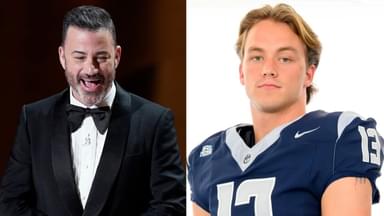After four years of unregulated money flooding into college football, the “Wild Wild West” days of the NIL may finally be winding down.
Advertisement
The long-awaited House v. NCAA settlement has been ratified, and it introduces a seismic shift to college athletics. Starting July 1, 2025, schools will be able to directly pay athletes through formal contracts, but under a hard salary cap.
Additionally, programs that opt into this agreement will be allowed to share revenue with athletes, capped at $20.5 million per year per school. Although this cap is expected to grow over time, for now, it becomes the upper limit of what any school can spend across all varsity sports, not just football or basketball.
This fundamental restructuring of athlete pay has caught the attention of NFL veterans and former college stars like Taylor Lewan and Will Compton. They didn’t hold back when discussing the implications of these changes.
“I love the idea of a cap,” Lewan said on the latest episode of the Bussin’ With the Boys podcast. “In the sense that all these major schools are now on the same playing field.”
Lewan’s point hits a growing concern in college football circles: parity. Without limits, NIL money has turned recruiting into an arms race. How?
Schools with deep-pocketed boosters and donor-backed collectives were regularly outbidding smaller programs, creating a system where athletes chase the highest bidder, often jumping schools mid-career.
“It’s the Wild West, bro,” the former Titans tackle added. “Right now it’s just, ‘who’s got the biggest bank account.’ That’s how I feel.”
This newly added upper limit for spending, Lewan believes, could restore some much-needed level of balance and loyalty in college football, which was missing in the last 4 years of the NIL era.
“Now we can kind of get back to, ‘I grew up a fan of this team, I’m loyal to this team,’” he said. “This is our team—not, ‘It’s springtime, I’m not getting enough snaps, I’m gonna get the hell out of here.’”
Will Compton, Lewan’s co-host, echoed similar concerns. However, he focused on what’s still missing: enforceability. “It’s legitimately, for me, like: when’s the rule going to come out where kids and athletes can be locked into multi-year deals?” Compton pondered.
That question cuts to the heart of the new model. While schools can now offer revenue-share contracts, their binding nature remains unclear. Recent high-profile cases, like Madden Iamaleava transferring from Arkansas to UCLA despite having a contract with a buyout clause, highlight how murky the NIL legal framework is.
“There’s so much money,” Lewan said. “All this is telling me, based on the little things I know, is $20.5 million is just being added to everything else that’s going on right now.”
And he’s not wrong. The NCAA expects compensation (between revenue share, scholarships, and benefits) to eventually reach close to a whopping 50% of athletic department revenue at some schools. That’s a dramatic departure from the amateur model that college sports were built on, and the scary part is, it’s only the beginning.
The former NFL star, however, continued championing the newly implemented cap by pointing out how it could also help solidify team culture and commitment, especially if combined with contract terms that actually stick. “Have one fixed area for free agency or the portal,” he said. “Then it’s a contract — you are here unless these things happen.”
But until courts settle whether these contracts are truly enforceable, schools will continue to operate in a legal grey zone.
For now, the only certainty is the number: $20.5 million. So until further notifications, every power-conference school will have to make it work within that limit, while still trying to land and retain top-tier talent.
With more than 70% of that money expected to go to football alone, expect the elite programs, those who already recruit well and spend big, to only strengthen their grip.
Because the question isn’t just who gets paid anymore. It’s who stays, and why. A sentiment Taylor Lewan summed up best: “Everyone’s getting paid, that’s great. But you chose to come here knowing the money was basically the same in a lot of places.”







